On the Hunt for Fastest Known Times
With COVID-19 around many athletes have found new adventures to tackle, but Alyssa Godesky already hunted for unique challenges well before most races were forced to cancel or postpone this year. FKT is the abbreviation for Fastest Known Time and Godesky in 2018 managed to grab one on the 273 mile Vermont Long Trail. We sat down with her to talk about racing, training, coaching and seeking adventures.
Slowtwitch: Thank you for your time Alyssa.
Alyssa Godesky: Thanks for having me!
ST: What is currently on your schedule?
Alyssa: Great question, but nothing too concrete. I’m coming off 6 weeks of unstructured training, and just starting to get back onto a plan. I’ll spend the next month getting the basics back, and in November hopefully I’ll have a better idea of what is next. Going for a sub 3-hour marathon? A trail adventure? Hitting the Zwift racing scene? I’ll have to see how the next few weeks pan out and what the odds of some real races happening are over the winter before I make any decisions. For now, I’m happy just getting some structure back and enjoying the beautiful Autumn training weather in the Blue Ridge mountains.
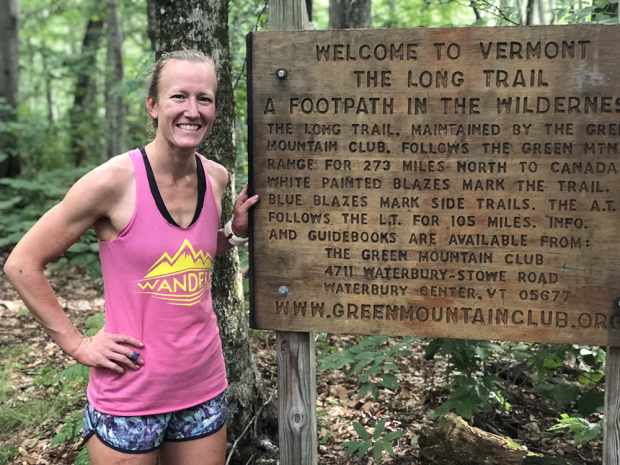
ST: What color are the leaves as we speak and how low do the temps get right now?
Alyssa: Down here in town in Charlottesville, things are still pretty green. But I spend a lot of time up in the Shenandoah National Park area, and once you’re around 2.5-3k feet of elevation, the leaves have just started to turn a beautiful yellow and orange. It’s also that perfect 2-week window where they’ve turned but aren’t really falling yet — when they start to fall, it makes trail running quite a bit trickier as they cover all the rocks and roots.
Temperatures typically these days hit a low in the mid-50’s so it’s pretty mild, but every now and then you’ll get a chilly morning in the 40s.
ST: The other day you were featured on NPR’s Morning Edition as they talked with you about your Adirondack FKT adventure. Was that the first time for you to be on NPR?
Alyssa: It was! I had a good relationship with the reporter from her initial report of my FKT for North Country Public Radio. I was super excited for her that the FKT action was getting picked up for a national story, and it was fun to work with her on that.
ST: The story on NPR was about the trend of folks pushing for Fastest Known Time on various routes because with COVID-19 there is seemingly not much else to do. Although I run a lot on trails myself, I only recently heard about FKT and in fact had to Google search it then, but you already did an FKT effort successfully in Vermont back in 2018. Can you talk what inspired you back then?
Alyssa: In 2014, a documentary called Finding Traction was released (it’s still on Netflix!) which documents legendary ultrarunner Nikki Kimball and her quest for the overall FKT on Vermont’s Long Trail. She ultimately fell short of the overall record, but established a women’s benchmark nonetheless. I saw that film and couldn’t shake the thought that I wanted to do what she did. Being able to see her attempt before my eyes made me think about ways I could improve and perhaps come out on top, despite being the slower runner on paper. I was able to see how much things like planning, logistics and purely just efficiency could play out in these multiday, long efforts. That stuck in my brain until 2017, when I was a little bit uninspired to do another iron distance race after 30 or so of them, and I decided to mix it up. I talked to my coach, Hillary Biscay, about putting the Long Trail project on the calendar for 2018, and she was all for it. So, the wheels were put into motion!
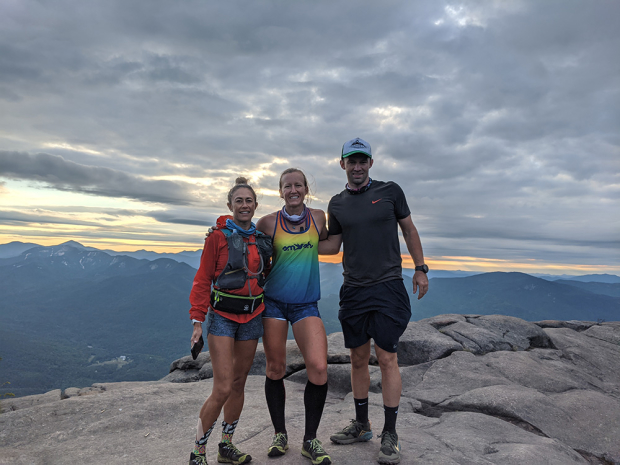
ST: Talk about your planning and how it went.
Alyssa: When I plan something like this, I go all in. The Long Trail is 273 miles long, and I wanted to see as much of that as I could ahead of time. I took a scouting trip in the fall of 2017 to see some miles, and then I spent about 8 weeks ahead of my attempt living in Vermont so I could train on the Long Trail. I was living and breathing the Long Trail. Training wise, I was doing a lot of volume, but a lot of the training is also about shifting your mindset and your body to be ready to be moving for 20 hours a day, for multiple days. A supported effort also meant I’d have a crew and pacers with me – but it’s a lot of planning that goes along with that so they can show up and help execute. I made a binder with all the nuts and bolts: from pacing projections to the fueling plan, to the crew driving directions between each checkpoint, reservations for where they’d be staying, etc.
Ultimately, the Long Trail was a success! I ended up getting the record in 5 days, 2 hours and 37 minutes. It was my first attempt at something like this, and I learned so much about fueling, pacing, and most especially the sleep deprivation side of things. These were all aspects I carried into my run in the Adirondacks this year for the 46 High Peaks. My route for the High Peaks was much shorter than the Long Trail. You can make your own route for the peaks, as long as you climb them all, and my route was 160 miles. Despite that, there was still so much planning and scouting that had to happen because some of the miles were off-trail bushwhacking. I was also going to be tackling the same amount of vertical 65,000 feet gain as the Long Trail but in 100 less miles. And there’s still all the planning for the crew and logistics that has to happen. Once the clock starts in an FKT attempt – to me, that’s the best part. I don’t have to worry about the details anymore – I just get to hike!
The ADK46-er run was also a success, as I set a women’s supported record in 3 days, 16 hours and 16 minutes. This time is actually the second fastest ever, male or female in the High Peaks, which was a pretty remarkable feat seeing a couple of the names that I beat on the men’s leaderboard. I am proud of the effort, and I am also proud that the effort raised $6.5k for The Paden Institute and Retreat for Writers of Color. A small part of the Center for Law and Justice in Albany, the Paden Institute, sponsors writers of Color to come up to a cottage in the Adirondacks each summer to write, hopefully sharing the Adirondacks experience with others. It was just a small way to contribute towards making the outdoor space a more inclusive place, and I have no doubt that having a greater purpose behind the run helped me get through it successfully.
ST: But you are actually known mostly as a professional triathlete.
Alyssa: Probably. I started out in the ultrarunning world, but back in 2006-2010 when there wasn’t the boom that there is now. I had great results, but since then the sport has evolved so much and the competition is fierce. While I’ve been on the trails a lot still, it’s not necessarily in the traditional racing scene, so I’ve stayed off of most people’s radar. But my affinity for doing so many iron-distance races has kept me relevant in triathlon! So yeah, I bet most people reading this know me as a professional triathlete.
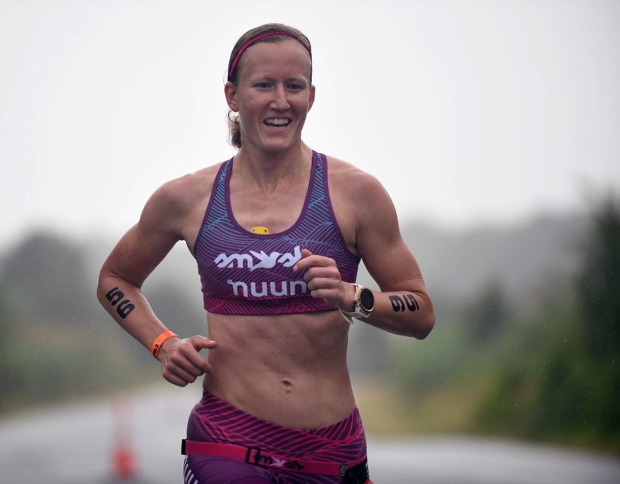
ST: When did you first get introduced to triathlon and how?
Alyssa: I did my first two years of undergrad at the Naval Academy, and when you’re there you have to play a sport. I played club lacrosse for a bit, but then needed a change. I contacted the triathlon coach, but he told me I wasn’t good enough! To be fair, I had zero experience, so I probably wasn’t. I ended up transferring to the University of Virginia for my last 2 years of undergrad and joined the club triathlon team there. The team had a lot of hidden talent, and we just had a lot of fun. The triathletes were a great balance of hard training but also enjoying the social side of college.
When I graduated and moved to Baltimore City for work, triathlon just made more sense than trail running due to geography and the group of training partners that I had fallen in with. I had been doing some long trail races to that point, so I naturally gravitated towards the Ironman, and signed up for IM Louisville as my first Ironman in 2009. Needless to say, I loved it! I raced a little bit more before I realized that I wanted some guidance for training, and that is where Hillary came in. I have now raced over 30 Ironman events with her coaching me!
ST: At one point you decided to drop your corporate career and focus fully on triathlon, or maybe I should say athletics. When was that and how was that transition?
Alyssa: In 2013 I was working for AOL as a Business Analyst. I loved the job, the pay, the lifestyle. It was a very good life for a 28-year old. But I was burning the candle at both ends. I had been training under the guidance of Hillary Biscay for 3 years, and through that time we had been putting into motion a plan to get me racing in the professional ranks. I was working a lot, and I was training a lot. I knew I couldn’t stay sane doing all of that – or give either my job or triathlon 100%. I had to pick. The mentors I had at AOL were amazing and supported me to give triathlon a go. Hillary had mentored me through those earlier years and helped me be ahead of the curve by encouraging me to save some money, and make some plans for part time work, etc. I also began coaching during this time. After leaving AOL at the end of 2013, I moved to Charlottesville, VA on January 1, 2014. I was a nanny, I worked part time for a race production business, and I focused on building my coaching roster. Over the next year I focused on building coaching, so I truly had the freedom to be racing and training where I wanted to be. Coaching is a full workload, but I am able to do it from anywhere. Knock on wood, I haven’t looked back!
ST: How many folks do you coach, and are they mostly triathletes?
Alyssa: I generally have 16-20 athletes at a given time. About half of them are purely triathletes, and the others are triathletes who dabble in trail running and adventures like myself or are pure runners and ultrarunners.
ST: What about the female – male ratio?
Alyssa: Around a fourth of my athletes are male. This is pretty consistent across the Biscay Coaching team of athletes.
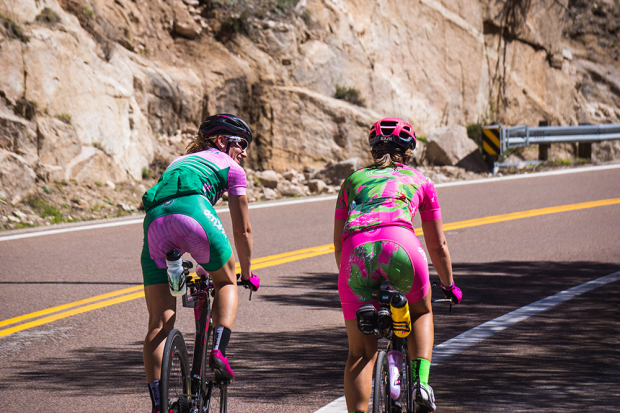
ST: Looking back over the years, which race effort are you most proud of?
Alyssa: 2015 and 2016 were banner years of iron distance racing for me. In 2015, I raced IM Copenhagen and IM Vichy just 7 days apart, placing 6th and 4th respectively, both sub-10 hours. In 2016 I wanted another attempt at the double, so I did IM UK and IM Switzerland, placing 4th and 8th, and then about 6 weeks later was 4th at IM Wisconsin. It was a lot of racing, I had a blast, and it was paying off.
These days I’m still super proud to be setting records on the trails and managing to finish in the money at a 70.3 (Eagleman 2019) as well as Ironman (New Zealand 2020). I wouldn’t say I’m at my best with triathlon while I’m trail running a lot, but I’m holding my own and I’m proud of that.
ST: What about disappointments?
Alyssa: I was excited to return to IM Copenhagen in 2019 and was gunning for a PR (my current best is 9:33 set there in 2017). I just couldn’t pull it out on the run. Those days are tough.
ST: What about highlights and disappointments trail running wise?
Alyssa: Setting speed records on the Long Trail and the 46 High Peaks in the Adirondacks are easily the highlights. I’m not sure any race can match the feeling of a successful multi-day effort like that. Especially this year, with the record in the Adirondacks, another woman started on the same day going for the same record. Racing over 3+ days like that head to head and having my friends and family play integral roles as crew – it is just so special to race like that. I can’t match it.
In terms of disappointments on the trail, if anything, I’m disappointed I haven’t done more traveling to see trails around the world. Hopefully I will in the future. In 2019 I ran from Bilbao to Gastiez in Spain, a 110km trail race, and it was super cool to race there. I’d love to do more of that, and I’d love to do more swim-run. I think that might be my wheelhouse! I’m an average swimmer in the pro ranks, but with paddles I can hang at the back of the above average pack. With that, and my trail running abilities, I think I can hold my own in SwimRun. As you know, I was getting ready to race SwimRun NC this year, but hopefully next year we’ll be there.
ST: Have you done a SwimRun race before and what made you decide on SwimRun NC?
Alyssa: Savageman 2019 was a 3-day event, with the first day being a SwimRun sprint. It was something like swim 250 meters, run a mile, three times through on a loop course. I thought I’d hate it, especially because it was so short, but I loved it! I had heard such great things from friends about SwimRun NC, and the pictures of the trails show some technical stuff which I love, I wanted to race there myself!
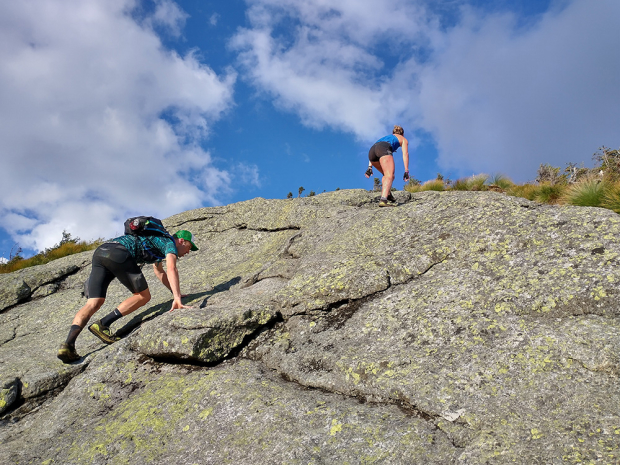
ST: Talking about wanting to race, what is still on your bucket list of races or events you want to tackle?
Alyssa: I’ve been thinking about Norseman more and more. I also have never travelled to South America, and there is a lot I want to see there, so I’d love to do a race there. In terms of ultrarunning, UTMB is a big bucket list item for me. I didn’t make it in via lottery for 2020, and now with COVID who knows how entry will unfold, but I’d love to be on the start line there in the near future.
ST: Talk about your weekly training load.
Alyssa: It varies so much depending on what project I am currently working on. In a peak phase for ultrarunning or ironman, I’m always on the higher volume side of things, ~30 hours a week. Whether that’s time in the saddle, or time with a weight vest on getting some vert – it depends what I’m getting ready for.
ST: What about your diet?
Alyssa: I eat everything! Back in the good old days, it was Taco Bell and Twizzlers. When I got serious, I felt like I needed to clean things up, and I’ve come a long way. I try to cook as much as I can and eat fresh foods. I eat meat, but I generally try to keep it from my locally sourced farm-share. My candy addiction is better than it used to be.
ST: Which sweets still get your attention?
Alyssa: There is a type of Twizzler that is a filled twist – basically taking a Twizzler and stuffing it with more sugar inside – those are my favorite! But I also love the basics, anything chocolate and peanut butter, jellybeans, etc.
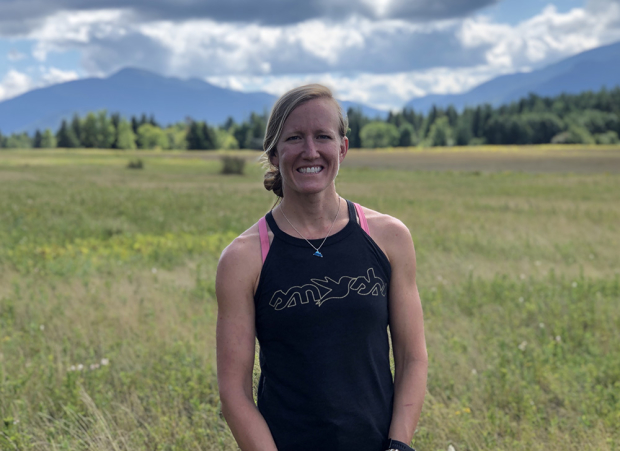
ST: is there anything else we should know?
Alyssa: I’ve been able to stay relevant in endurance sports for 10 years in no small part to the work that my coach, Hillary Biscay, has put in. She has taken me from an athlete with potential, to someone who has made a mark on history with trail records and consistently making a paycheck from Ironman racing. That’s pretty awesome. I’ve also been a longtime athlete with Smashfest Queen, Nuun Hydration and ISM saddles, all of which allow me to keep pursuing my athletic goals year after year. Oh, and if you want to hear more from me, I co-host the IronWomen podcast with Haley Chura – it comes out weekly on Thursdays!
You can follow Alyssa Godesky on Instagram via @alyssagodesky
Image 3 © Yuchen Nie
Image 4 © Brent Ellabarger


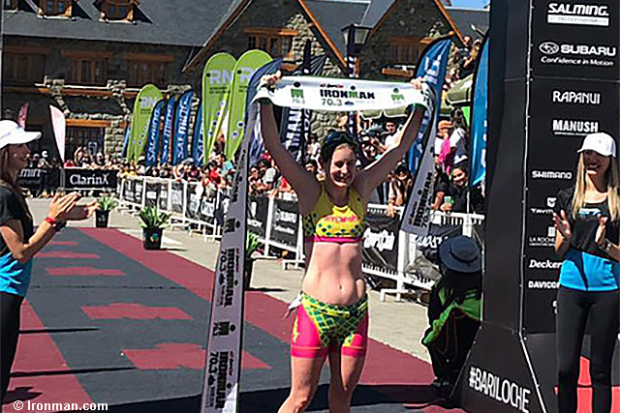
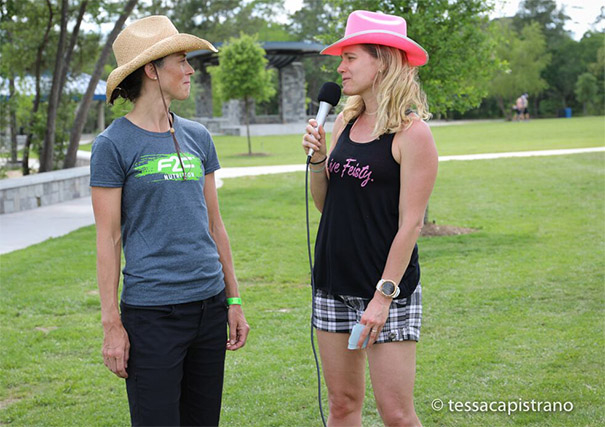
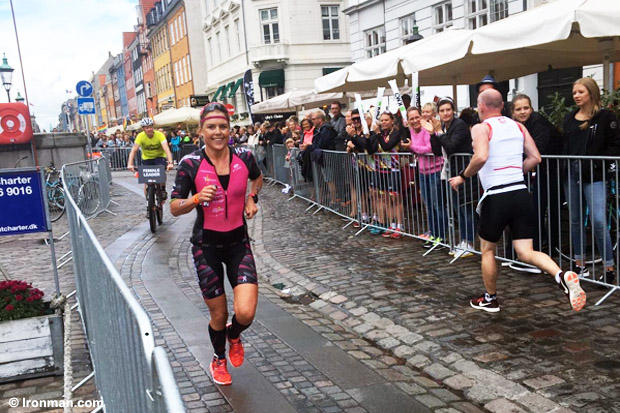
Start the discussion at forum.slowtwitch.com